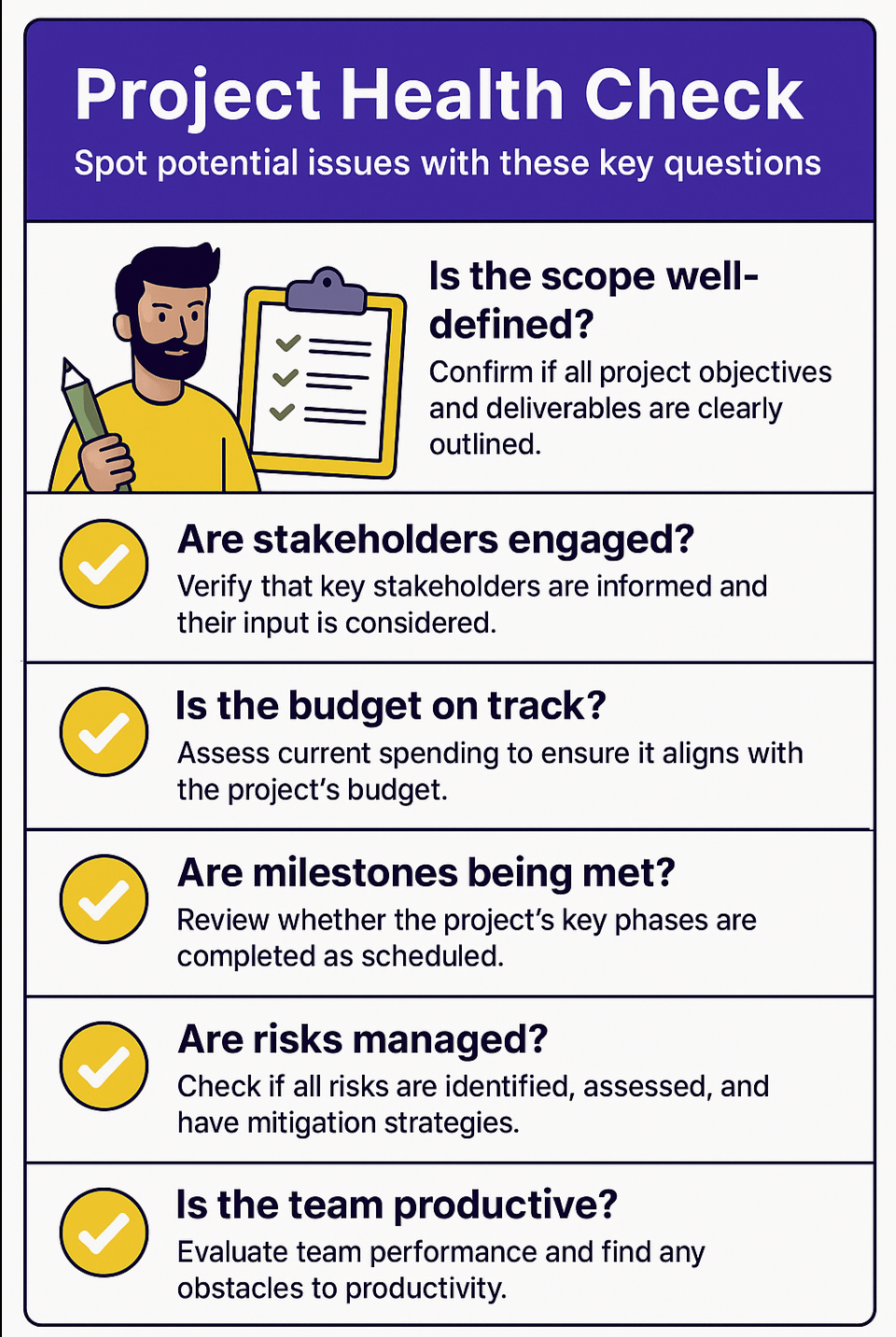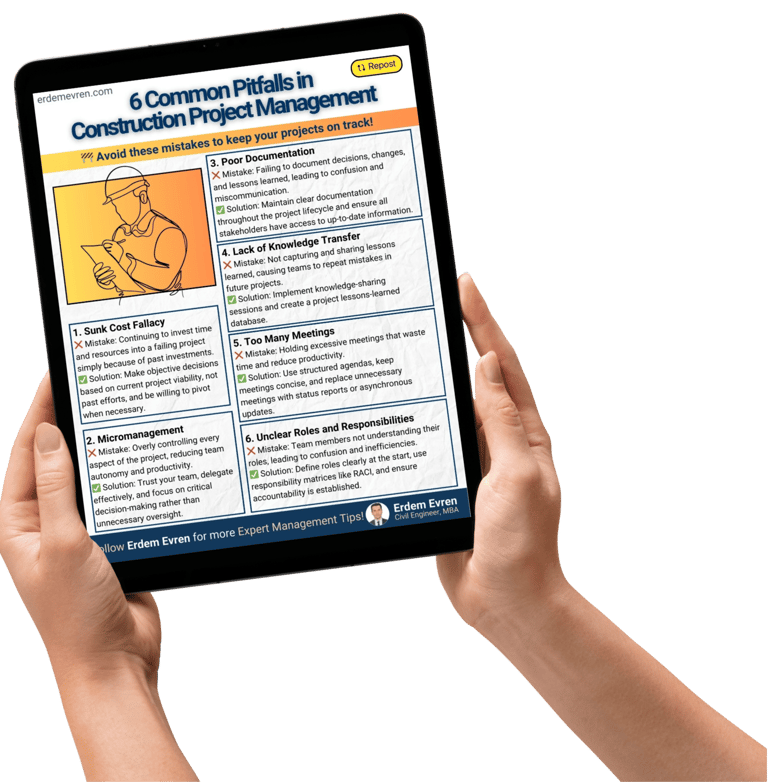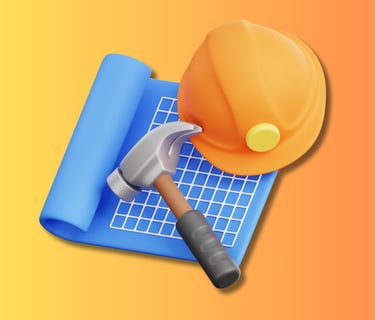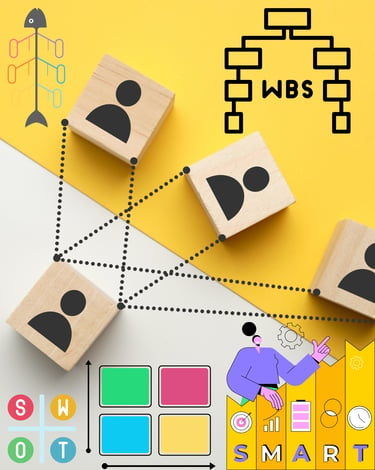BLOG 104 - "Checklist" - Are Your Projects Missing the Mark?
Learn how strategic checklists enhance construction project success by improving task tracking, team accountability, and execution quality. Discover why checklists are essential tools for project efficiency and risk reduction.
by Erdem Evren
6 min read
Imagine embarking on a journey without a map or a plan; navigating through the unknown can be daunting and chaotic. In the world of project management, a checklist serves as that crucial guide, ensuring every essential task is identified, tracked, and completed, leading to the successful completion of projects. Have you ever overlooked a critical detail in a project, only to realize its importance later? A checklist is your safeguard against such oversights.
A checklist in project management is not just a to-do list; it's a strategic tool that breaks down complex projects into manageable tasks, ensuring consistency, efficiency, and quality in execution. For example, consider the launch of a new product. A comprehensive checklist for this project might include market research, product design, prototype testing, marketing strategies, and launch events, each with its own set of subtasks.
Effective checklists are adaptable. They're not one-size-fits-all but tailored to the specific needs of a project, incorporating industry standards, organizational procedures, and project complexities. For instance, a software development checklist would differ significantly from a construction project checklist, emphasizing code reviews, testing phases, and deployment steps.
Moreover, checklists foster team collaboration and accountability. When each team member is clear on their responsibilities, as outlined in the checklist, it reduces ambiguity and enhances productivity. Imagine a project where tasks are assigned and updated in real-time through a digital checklist platform, allowing team members to see progress and tackle pending items efficiently.
In crafting your checklist, prioritize clarity and simplicity. Use actionable language, and break down tasks into clear, achievable steps. Incorporating deadlines and responsible parties for each task further enhances the utility of the checklist.
To sum up, a well-designed checklist is a powerful tool in the arsenal of project management, transforming complex undertakings into structured, achievable milestones. It's the roadmap that guides teams through the intricacies of projects, ensuring no detail is overlooked, and every task is systematically approached and completed. How do you incorporate checklists into your project management practices? Share your experiences and tips for optimizing this invaluable tool.
Erdem Evren
With a career in ENR 250 Global Contractor Companies spanning multiple construction projects across Canada, Türkiye, Russia, Saudi Arabia, Kazakhstan, Libya and Azerbaijan, He specializes in construction automation systems, AI integration in project management, and sustainable building practices. Through his blog and professional network, he shares templates, tools, and AI workflows tailored for modern construction needs.
Sign up for emails and be the first to see helpful how-tos, insider tips & tricks, and a collection of templates & tools. Subscribe now.






Civil Engineer, MBA


Table of Content
HOW TO?
STEP 1
Creating and utilizing a project management checklist involves several steps, from initial planning to ongoing adjustments. Here's a detailed approach with examples and tips:
Define Project Objectives and Scope:
Start by outlining the project's goals and boundaries. This clarity ensures your checklist focuses on what's essential, avoiding scope creep.
Example: For a website redesign project, objectives might include improving user experience, increasing load speed, and refreshing the brand's visual identity.
STEP 2
Break Down the Project into Major Milestones:
Identify key phases or milestones in your project. These serve as the main sections of your checklist.
Example: Major milestones for a product launch might include Concept Development, Design & Prototyping, Testing, Production, and Market Launch.
STEP 3
List Tasks Under Each Milestone:
For each milestone, enumerate the specific tasks required. Be as detailed as possible to avoid ambiguity.
Example: Under Testing for a software project, tasks might include Unit Testing, Integration Testing, User Acceptance Testing, and Beta Testing.
STEP 4
Assign Responsibilities:
Clearly indicate who is responsible for each task. This accountability ensures tasks are completed on time.
Example: Assign a marketing team member to 'Develop Launch Campaign' and a designer to 'Finalize Product Packaging'.
STEP 5
Set Deadlines:
Establish realistic deadlines for each task to maintain project momentum and ensure timely completion.
Example: Set specific weeks for the completion of each phase of the testing process.
STEP 6
Integrate Flexibility:
Allow for some flexibility in your checklist to accommodate unforeseen changes or adjustments.
Example: Include buffer times between major milestones for review and refinement.
STEP 7
Review and Refine:
Regularly review the checklist with your team to update task statuses, refine tasks, and make necessary adjustments.
Example: Hold weekly meetings to discuss progress, challenges, and updates to the checklist.
STEP 8
Use Project Management Tools:
Leverage digital project management tools to create, share, and update your checklist in real-time.
Example: Platforms like Trello or Asana allow for interactive checklists with features for assigning tasks, setting deadlines, and updating statuses.
STEP 9
Communicate Progress:
Keep stakeholders informed about the progress by sharing updates based on the checklist.
Example: Send out bi-weekly newsletters to stakeholders summarizing completed tasks and upcoming goals.
STEP 10
Reflect and Learn:
After project completion, review the checklist's effectiveness. Discuss what worked well and what could be improved for future projects.
Example: Conduct a post-project review meeting to gather feedback on the checklist process and identify lessons learned.
Tips and Tricks
Keep it Simple: Avoid overcomplicating your checklist. Use clear, concise language and straightforward tasks.
Prioritize Tasks: Use a system (e.g., high, medium, low priority) to highlight the most critical tasks.
Use Checkpoints: Include regular checkpoints to assess progress and adjust the checklist as needed.
Be Collaborative: Involve your team in creating and updating the checklist to ensure buy-in and comprehensive coverage of all tasks.
Visual Elements: Incorporate visual elements like color-coding or icons to make the checklist more user-friendly and easier to navigate.
By following these steps and incorporating these tips, you can create an effective project management checklist that keeps your project on track and ensures that no detail is overlooked.
INFOGRAPHIC


Want Smoother Projects?
Learn from 20+ Years of Global Experience
Join 2000+ professionals from around the world!


Sign up for emails and be the first to see helpful how-tos, insider tips & tricks, and a collection of templates & tools.
No spam. Just real, proven advice that works in the field. Join now.
About
Erdem Evren is an accomplished civil engineer and construction project management expert with a unique blend of engineering precision and business strategy. He holds a Bachelor of Engineering in Civil Engineering from Dokuz Eylul University and a Master of Business Administration from Izmir University of Economics. His academic foundation is further strengthened by a Project Management Certification from Istanbul Technical University, along with two Canadian post-graduate honours programs—Construction Project Management from Centennial College and Project Management from Georgian College—equipping him with a rare blend of technical precision and strategic leadership across global construction markets.
With a career in ENR 250 Global Contractor Companies spanning multiple construction projects across Canada, Türkiye, Russia, Saudi Arabia, Kazakhstan, Libya and Azerbaijan, He specializes in construction automation systems, AI integration in project management, and sustainable building practices. Through his blog and professional network, he shares templates, tools, and AI workflows tailored for modern construction needs.
















